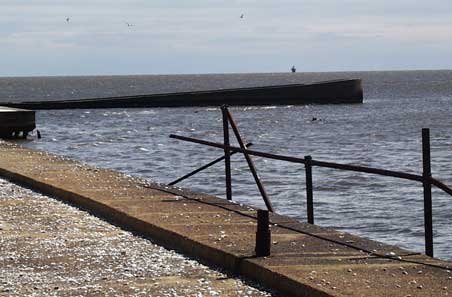|
What's up with the
three sunken barges off the cement pier in North Point State Park? As
anyone who's spent much time on the Curtis Creek Bridge can tell you,
sunken abandoned barges are neither pretty (Yes
they are!) nor uncommon. In the old days, when people were done
with barges, their idea of an environmentally sound disposal solution
was dump the barge in the shallows and let it rot. So I wasn't particularly
enthused when I received Mr. Kotowski's question. Rotting barges are
rotting barges, right? Well, I've been wrong before.
It turns out that there's a tale behind these barges other than your
typical squalid-scow-sinks-in-solitude story. This was not apparent
at first. Like most people, I had never seen the particular barges in
question. The closest I had ever been to being in North Point State
Park was driving through to get to Miller's Island. So, when I started
investigating, I took it on faith the barges existed. To be honest,
I took it on faith that the pier existed, too. To be perfectly honest,
I often have difficulty believing that people don't cease existing just
because I can't see them anymore, but that's just my own epistemological
problem.
Anyway, it was with cautious mien that I called the park to see if they
knew anything about these barges. What I first learned was disheartening.
North Point State Park is under the jurisdiction of Gunpowder State
Park and the phone number in the book for North Point actually puts
you through to Gunpowder. At that time, a psychopath (excuse me, alleged
psychopath) was on the loose in those very woods, so I could imagine
how pleased the rangers there would be to drop everything to answer
my little question.
Fortunately, I was quickly given the number for the ranger station in
the park I wanted (this extra step was necessary, I suppose, because
the government feels that listing the actual number for the correct
park in the phone book would be too confusing for people).
At last, merciful fate led me to Steve Takos. Mr. Takos is a 76-year-old
volunteer ranger at North Point State Park who has been working in the
area for more than 60 years. I went down to the park to meet him.
Have you ever been there? Park employees call it the best-kept secret
in Baltimore County, and I could see why. Right here in Greater Dundalk
is a beautiful expanse of natural wonder, complete with a forest, salt
marsh, shoreline and the relics of the old Bay Shore Amusement Park,
one of America's great, lost trolley parks. The park also has an old
cement pier, now a protected nesting site for terns. Perpendicular to
the pier, about 60 feet out from its end, lie three long, concrete barges
sunk in a straight line to form, with the pier, a giant "T."
Mr. Takos, who seemed to know everything about the area, told me the
story.
In the late 1890s, while construction of Bay Shore was under way, the
developers built a wooden pier to accommodate a ferry from Tolchester
that would bring Eastern Shore visitors to the site. Bay Shore opened
in 1906, but the pier was destroyed by a hurricane in the late 1910s.
It was decided that the new pier, as Shakespeare would stay, should
be made of sterner stuff, so they built the current concrete dock.
Bay Shore closed in 1947, a victim of changing habits and the rising
use of the automobile, a development that destroyed the advantage of
the old trolley parks. Prior to the death of Bay Shore (at least at
that site), the land had been purchased by Bethlehem Steel. After the
passing of the park, Beth Steel used the land as a private hunting preserve
for its executives. In the early 1950s, Sparrows Point Country Club,
another perk for Beth Steel execs, was under construction. To beautify
the river view from the club, Beth Steel removed from Bear Creek three
abandoned concrete barges that had been used to transport munitions
in World War I. (Apparently, concrete barges ensured that, if a load
of munitions went off and killed everyone nearby, you at least wouldn't
lose the barge. Priorities were different back then.)
The barges were raised, moved to the end of the old ferry pier and intentionally
resunk to create a breakwater to protect the slowly crumbling structure.
Later, the steel wizards at the plant created two custom-designed metal
boxes that were installed at each end of the line of barges to serve
as duck blinds so that execs skilled at making a killing in the steel
market could try their hand at new kinds of carnage.
In the mid-1980s, the plant manager scaled back executive privileges,
and the blinds were abandoned. In 1987, the state purchased the property
and it was organized into the park we see today. When the terns aren't
nesting, permit holders can still use the old duck blinds, which Mr.
Takos describes as "the best on the Chesapeake Bay."
So the barges lie there as active parts of the great recycling engine
of history. They serve as reminders that, if you build something to
last, as long as it's not a distillery warehouse, people will continue
to find uses for it.
Copyright 2003 Dundalk Eagle
Taken from:- www.dundalkeagle.com
|
